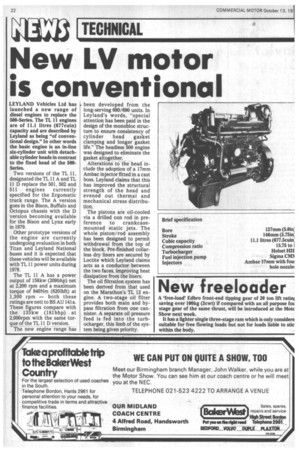New LV motor is conventional
Page 24

If you've noticed an error in this article please click here to report it so we can fix it.
LEYLAND Vehicles Ltd has launched a new range of diesel engines to replace the 500-Series. The TL 11 engines are of 11.1 litres (677cuin) capacity and are described by Leyland as being "of conventional design." In other words the basic engine is an in-line six-cylinder unit with detachable cylinder heads in contrast to the fixed head of the 500Series.
Two versions of the TL 11, designated the TL 11 A and TL 11 D replace the 501, 502 and 511 engines currently specified for the Ergomatic truck range. The A version goes in the Bison, Buffalo and Octopus chassis with the D version becoming available for the Bison and Lynx early in 1979.
Other prototype versions of the engine are currently undergoing evaluation in both Titan and Leyland National buses and it is expected that these vehicles will be available with TL 11 power units during 1979.
The TL 11 A has a power output of 156kw (209bhp) net at 2,200 rpm and a maximum torque of 840Nm (6201bft) at 1,300 rpm — both these ratings are nett to BS AU 141a. These figures compare with the I35kw (181bhp) at 2,000rpm with the same torque of the TL 11 D version.
The new engine range has been developed from the long-serving 680/690 units. In Leyland's words, "special attention has been paid in the design of the monobloc structure to ensure consistency of cylinder head gasket clamping and longer gasket life." The headless 500 engine was designed to eliminate the gasket altogether.
Alterations to the head include the adoption of a 17rnm Ambac injector fitted in a cast boss. Leyland claims that this has improved the structural strength of the head and evened out thermal and mechanical stress distribution.
The pistons are oil-cooled via a drilled con rod in preference to crankcasemounted static jets. The whole piston/rod assembly has been designed to permit withdrawal from the top of the block. Pre-finished collarless dry liners are secured by Loctite which Leyland claims acts as a conductor between the two faces, improving heat dissipation from the liners.
The oil filtration system has been derived from that used on the Marathon's TL 12 engine. A two-stage oil filter provides both main and bypass filtration from one cannister. A separate oil pressure feed is fed into the turbocharger, this limb of the system being given priority.
























































































































































































































